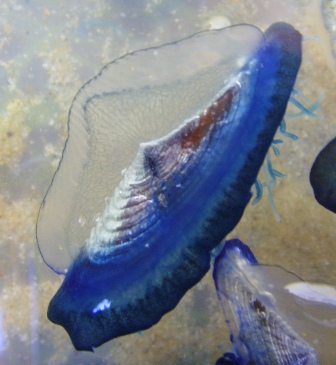- Series:Animals, Transcript English
Genesis 1:21
“And God created great whales, and every living creature that moveth, which the waters brought forth abundantly, after their kind, and every winged fowl after his kind: and God saw that [it was] good.”
Do you know how to handle a sailboat? If you had to sail to a destination that was not exactly downwind, would you be able to do it?
Unlike most jellyfish, velella does not merely drift with the wind. Velella has a triangular sail.  However, unlike some jellyfish with sails, velella’s sail doesn’t simply catch the wind and move velella along with it. Velella’s triangular sail has an S-shaped base so that it can stand up to winds from any direction. The sail is set on top of velella’s body at an angle to its length. This makes velella a biological oddity – because its body is not symmetrical.
However, unlike some jellyfish with sails, velella’s sail doesn’t simply catch the wind and move velella along with it. Velella’s triangular sail has an S-shaped base so that it can stand up to winds from any direction. The sail is set on top of velella’s body at an angle to its length. This makes velella a biological oddity – because its body is not symmetrical.
This asymmetry is not without purpose. The unusual body design of this jellyfish allows it to sail as much as 60° off the direction of the wind. This is what sailors call a broad reach. Some velellas have their sails tilted to the right, allowing them to sail up to 60° to the right of downwind. Others have their sails tilted to the left, allowing them to sail up to 60° left of downwind. What’s more, velellas can change their angle of sailing by extending or retracting their tentacles in the water.
When scientists noticed that velella’s body was asymmetrical, they immediately looked for a purpose behind the design. Even though many scientists will not recognize the Creator, they understand enough to realize that nothing in the creation is without purpose or design. So while many deny the Creator, they still recognize the pattern of His handiwork!
Prayer:
Lord, even though some reject You, despite their great knowledge of the creation, they cannot deny the principles of purpose and design with which You have made all things. For this I glorify You. Amen.
Notes:
“The by-the-wind sailor: a masterpiece of natural design.” Discover, Aug. 1987. p. 46.
